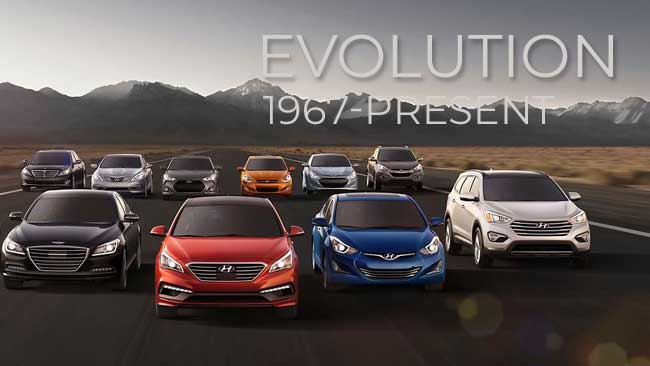A Journey Through Hyundai Design History – Hyundai, a name synonymous with innovation and evolution in the automotive industry, has carved a remarkable path through the decades since its inception in 1967. From humble beginnings as a builder of affordable economy cars to becoming a global powerhouse known for quality, style, and cutting-edge technology, Hyundai’s journey through design history is a testament to its relentless pursuit of excellence and adaptation to changing times.
Early Beginnings: 1960s – 1980s
Hyundai’s early years were marked by ambition and perseverance in the face of challenges. Established in 1967 by Chung Ju-yung, the South Korean company started out as a construction firm before venturing into the automotive industry in the mid-1970s. The first significant milestone in Hyundai’s design history came with the launch of the Pony in 1975. The Pony was Hyundai’s inaugural car and South Korea’s first mass-produced vehicle, setting the stage for what was to come.
The design of the Pony was straightforward and functional, reflecting the utilitarian needs of the market at the time. It featured clean lines and a no-frills interior, emphasizing reliability and affordability over luxury. Despite initial skepticism, the Pony’s success paved the way for Hyundai to expand its lineup and refine its design philosophy in the decades that followed.
In the 1980s, Hyundai began to assert itself as a global player in the automotive industry. The introduction of models like the Excel and Sonata showcased Hyundai’s growing design prowess and commitment to improving quality. These cars incorporated more modern design elements while remaining accessible to a wide range of consumers. The Excel, in particular, became a bestseller in various markets, cementing Hyundai’s reputation for delivering value and reliability.
Also Read : A Journey Through Hyundai Design History
Maturation and Innovation: 1990s – 2000s
The 1990s marked a period of maturation for Hyundai’s design language. As the company continued to expand globally, its design philosophy evolved to encompass more sophisticated aesthetics and advanced engineering. Models like the Accent and Elantra demonstrated Hyundai’s commitment to blending style with functionality, appealing to a broader audience seeking affordable yet stylish transportation.
One of the pivotal moments in Hyundai’s design history came with the appointment of Peter Schreyer as Chief Design Officer in 2006. Schreyer, formerly of Audi and credited with designing the iconic Audi TT, brought a fresh perspective to Hyundai’s design language. Under his leadership, Hyundai adopted the “Fluidic Sculpture” design philosophy, characterized by flowing lines and dynamic forms that imbued Hyundai’s vehicles with a sense of movement and elegance.
The introduction of the Sonata and Genesis sedans in the late 2000s exemplified Hyundai’s newfound design prowess. These models featured bold, sculpted exteriors and refined interiors that rivaled those of more established luxury brands. The Sonata, in particular, garnered acclaim for its striking design and innovative features, signaling Hyundai’s ambition to compete at the highest levels of the automotive market.
Modern Era: 2010s – Present
Entering the 2010s, Hyundai continued to push the boundaries of automotive design and technology. The “Fluidic Sculpture 2.0” design philosophy refined the earlier principles, emphasizing a balance of aesthetics and aerodynamics. Models like the Tucson and Santa Fe SUVs showcased Hyundai’s ability to adapt its design language across different vehicle segments, catering to diverse consumer preferences worldwide.
Hyundai’s commitment to innovation extended beyond aesthetics to include advancements in eco-friendly technology and connectivity. The introduction of hybrid and electric vehicles, such as the Ioniq and Kona Electric, underscored Hyundai’s dedication to sustainability and meeting evolving consumer demands. These models not only featured distinctive designs but also integrated state-of-the-art technology to enhance performance and efficiency.
In recent years, Hyundai has continued to evolve its design language with the introduction of the “Sensuous Sportiness” philosophy. This approach emphasizes emotional design elements that evoke a sense of excitement and passion, aiming to create an emotional connection between drivers and their vehicles. Models like the Hyundai Palisade and Sonata N-Line exemplify this philosophy with their dynamic proportions and expressive styling cues.
Conclusion
Hyundai’s design history is a testament to its journey from a regional player to a global automotive powerhouse. Through decades of innovation and adaptation, Hyundai has consistently pushed the boundaries of automotive design, blending style with functionality and advancing technological capabilities. From the simplicity of the Pony to the sophistication of the Sonata and beyond, Hyundai’s commitment to excellence in design continues to drive its success in the competitive automotive landscape.
As Hyundai looks to the future, its design philosophy remains rooted in creativity, innovation, and a deep understanding of consumer preferences. With each new model, Hyundai strives to redefine what is possible in automotive design, shaping the future of mobility and inspiring drivers around the world. As the automotive industry evolves, Hyundai stands poised to continue its legacy of design excellence, ensuring that each vehicle not only meets but exceeds the expectations of consumers worldwide.
Through its rich design history, Hyundai has not only transformed the way we perceive automobiles but has also set a benchmark for innovation and quality in the global automotive market. As we look ahead, one thing remains clear: Hyundai’s journey through design history is far from over, promising even more exciting developments and groundbreaking designs in the years to come.
(source)
Originally posted 2024-06-25 03:46:06.
